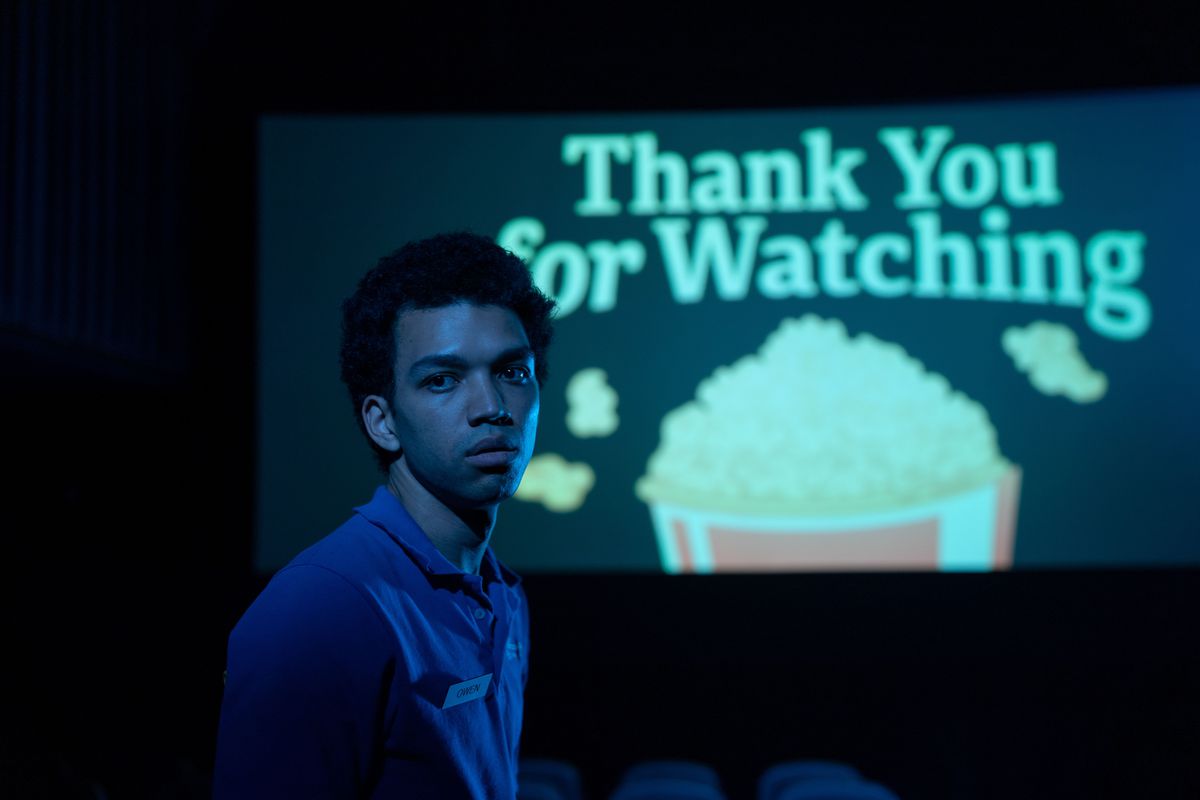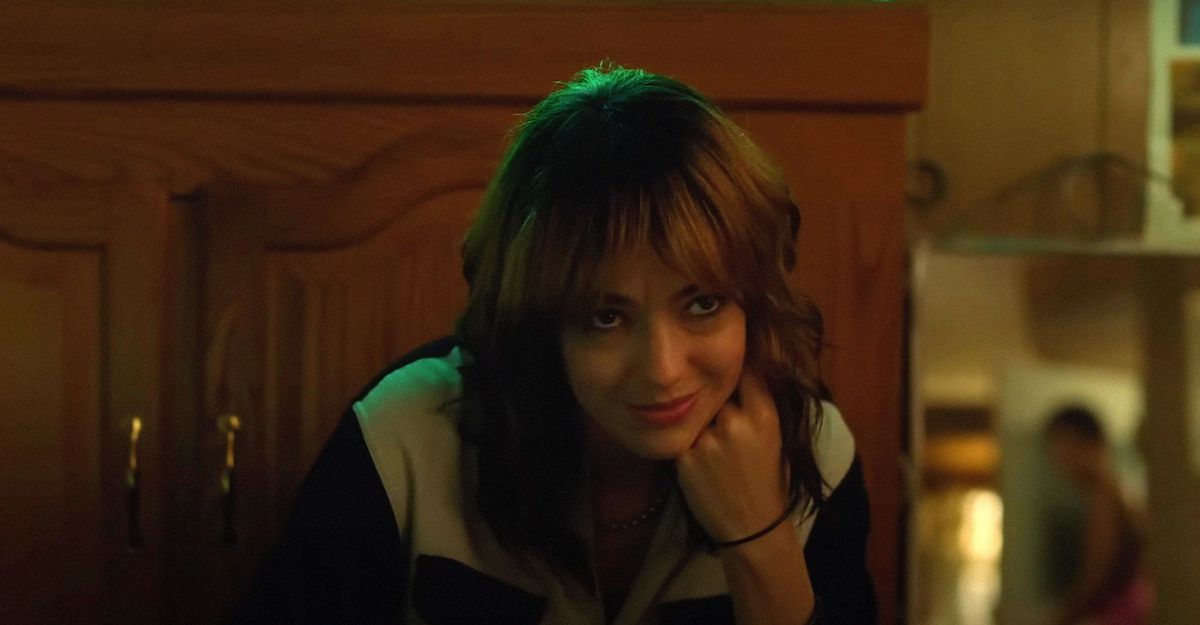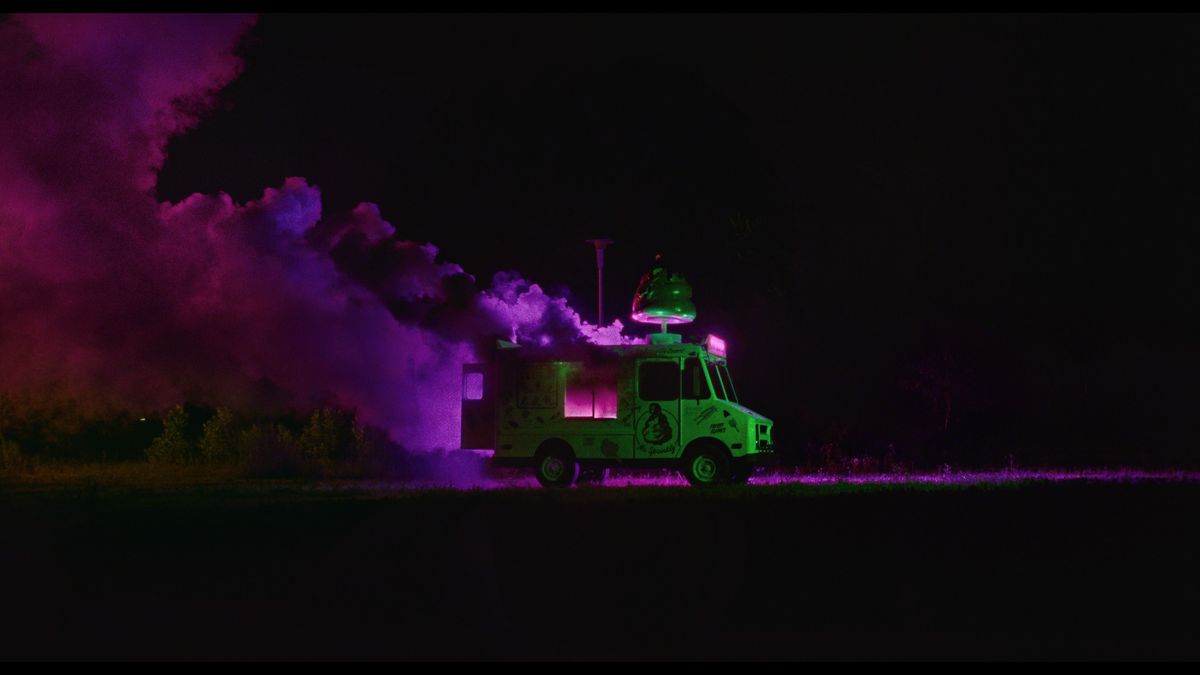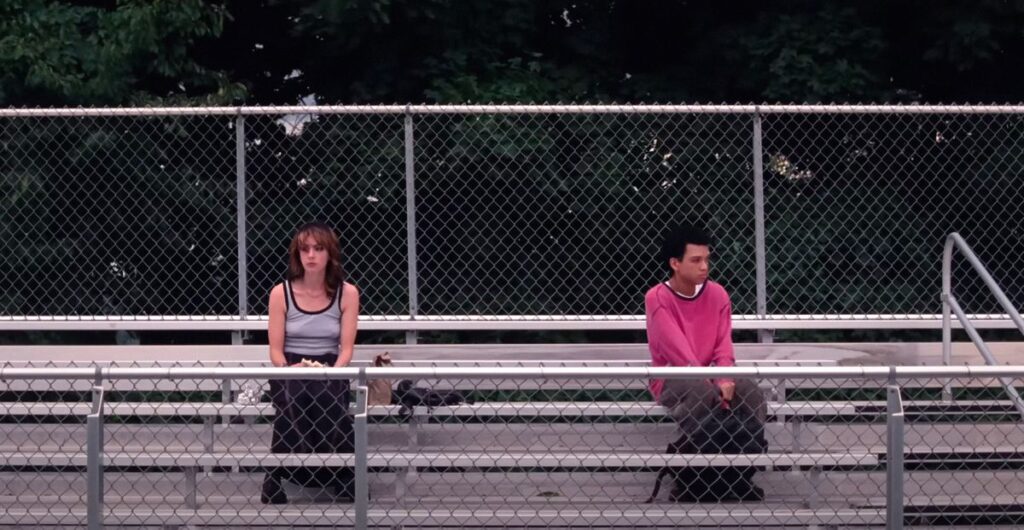I Saw the TV Glow is a rare treat of a movie. It’s equal parts dense, complicated, funny, and sad, all while being an absolute joy to watch. Its story is equally concerned with the pain of loving a TV show that ended too soon, and the pain of letting your whole life slip by without ever truly knowing yourself. Finding ways to communicate all these complicated ideas while still making a watchable, entertaining film is a big task, but TV Glow writer-director Jane Schoenbrun has experience with that.
Their fantastic first feature, We’re All Going to the World’s Fair, centers on a young woman who finds friendship online as part of a community obsessed with something called “the World’s Fair Challenge,” a viral ritual that supposedly changes the body of anyone who performs it. World’s Fair, and Schoenbrun’s earlier documentary about Slenderman, A Self-Induced Hallucination, are both deeply rooted in online communities, creepypasta, and how we find ourselves and our identities in the media we consume.
TV Glow takes that concept even further, following Owen (Ian Foreman and, as he gets older, Justice Smith) and Maddy (Brigette Lundy-Paine), two loners who bond over a shared love of a late-night TV show called The Pink Opaque — a mashup of ’90s TV hits that lives somewhere between Buffy The Vampire Slayer and Twin Peaks. Ahead of the release of I Saw the TV Glow, Polygon sat down with Schoenbrun to talk about their inspiration for the movie, their distrust of narrative convention, and the subtle ways all their films connect.
This interview has been edited for concision and clarity.
Image: A24/Everett Collection
Polygon: Where did this script start for you?
Jane Schoenbrun: My process is very weird. I say my process — I don’t think it’s the way people normally work when they’re trying to make a narrative film. Something will kind of get lodged in my brain. And that something could be just like a title or an image or an idea. That’s definitely not a movie. But it feels stuck, and it feels connected to a lot of nerve endings that can be investigated.
And so for me on this film, there was this idea of being haunted by an unresolved cliffhanger from a child’s show, and the idea specifically of the characters on the TV show being in a certain kind of danger. That [feeling of] not having resolution, and that making it hard to exist in the “real world,” to the point where you’re almost taking on the pain of those characters. And from there, I really wanted to investigate why that particular mental metaphor or idea, and this sort of unreality and merging of fiction and reality that’s inherent in it, was so close to me.
I knew fairly early on that what I was talking about was a trans experience and dysphoria. And as I was beginning to work through dysphoria and beginning my actual transition, I understood this as a movie about recognizing something that’s wrong, and about the process that goes into that recognition.
Do you think those feelings are similar for you, an unresolved TV show and the process of what it means to transition and to understand yourself better?
The queer philosopher Eve Sedgwick does a lot of literary theory. I was reading the intro to one of her books, and she’ll talk about, like, a Henry James novel and pick apart the queer themes that are embedded in the work, or inherent to the work, even if only in a way that feels subtle, or only hinted, or glimpsed.
She talked in this intro about, in childhood, finding these glimmers of a thing that at the time, she didn’t have the language to call queerness, but that she understood as some kind of signal that she wasn’t picking up elsewhere, that she wasn’t picking up in the immediate surroundings of the “real world” she existed within, and the straight world she existed within. And how she remembers almost making a promise to herself, whenever she would find these signals, these secret codes in the work that resonated with her, to look for that feeling in her adult life.
When I read this, I had already been working on the movie, and it felt so eloquent, obviously [in] a different medium, you know? She’s not talking television, but it felt like exactly what the movie is trying to speak about, which is when you’re young, and you see a glimpse of something that cuts through in the way that feels, like Maddy says, more real than real life. What do you do with that? And to what degree do you reassess the life that you’re in, that does feel real, to make room for that kind of transmission?

Photo: Spencer Pazer/A24
I think the characters [in TV Glow] are very much haunted by that question. This question becomes more urgent as they get older, and they maybe do start to realize the true implications of the ways in which reality feels insufficient to them. And certainly for myself — like, yeah, obviously, I’m not trapped in a TV show, to the best of my knowledge. But I think I was unpacking some very personal things that I was working through.
There have been a lot of conversations about the idea of representation in movies, but it’s very different to talk about people finding themselves in movies, TV, and art generally, and seeing things they may not realize are part of themselves until they see it on screen. I think I Saw the TV Glow is incredibly adept at showing that feeling.
I think on a very simple level, the concept of representation, the shallow identitarian representation, feels like mostly a tool of the oppressor. It’s like, Who is the audience that is for? I’m not sure that it’s for me, and trans people. We know we exist, you know? It’s for some kind of imagined idea of equality that will never actually exist, because we live in, like, a fundamentally evil, white-supremacist, capitalist hellscape.
But the idea of art creating possibility — or putting language to possibility — that previously felt either undefined or unimaginable feels to me like a form of representation, if you could even still call it that, that I could get behind. The idea of, like, a queer coming of age as something that’s inherently about creating unrealized or previously unrealized possibility, both on a personal and political level, and a piece of art that is speaking very honestly and personally about everything, that’s both liberatory and terrifying and difficult about that. I’m proud to have made that.
Why did you choose to center the story on Owen? Was there ever a version that explored more of Maddy’s story?
I think if you’re thinking about, like, what’s-his-name’s Hero’s Journey shit, then Owen is the least interesting character, in that he doesn’t so much grow as he decays. Until perhaps at the very end of the movie he’s discovering or seeing something that explains the decay. And in this sense, he could be called, by, like, a hack studio executive, a passive narrator.

Image: Everett Collection
At the same time, I think that kind of “passivity” feels inherently tied to an experience that I — and I think many other trans folks — can relate to on a deeply visceral level. It indicates exactly how our ideas about what proper narrative or progress is is not only woefully limited in the experiences it’s showing, but also like maybe by definition, masculine and cis. [It’s] reflective of an idea of agency and individual agency that doesn’t resonate with other experiences, like my own. And so I am trying to rewrite or call into question or challenge or simply just like, exist within alternative ideas of narrative structure, to express something that feels emotionally truthful to my experience in the world.
I had a meeting with a really smart producer for this film. And he was like, Listen, Owen is too passive. You need to rewrite this thing. Owen needs to be like, he got out of his home town and he’s coming back to visit, and all of these things are haunting him. This character is just a mess, and nobody wants to watch a mess.
In fact, this producer told me, Your audience is going to be convinced that Owen murdered Maddy, when Maddy disappears. Because you are playing against a century of Hollywood filmmaking about the reclusive, passive man who is secretly a psychopath, right? Like the lineage of Norman Bates or Peeping Tom; the stuck-inside-himself, freak, passive, strange recluse, a character we should be viewing with suspicion. And I was so fascinated by this. I was like, That’s a great point. And really interesting from a trans perspective, because of course, Norman Bates was trans. And so I do think part of if it feels wrong to you, to be watching a character who is so stuck inside himself in the way Owen is. And for you to sit with that and question it as narratively incorrect, like, what presuppositions are you bringing to the table with that?
Did you try to parallel and connect the suburbs as Owen experiences them and the world of The Pink Opaque?
There was an idea early on in the film that it all existed in sort of one realm, that the suburbs Owen exists within are heightened in the way that the suburbs were heightened in ’90s television. The suburbs The Pink Opaque is set within are some kind of reflection of that, or they’re all sort of occupying maybe the same solar system, but different planets, because the whole movie is sort of playing with the idea of the memory of an imagined ’90s suburban utopia, and also the memory of how the television of that time helped to create that idea.

Image: A24
And then I think what happens in the movie is, both the real world and the TV show transform as the movie goes on into something else, but they kind of transform in tandem, right? Owen’s world becomes a darker and more haunted place, as the show transforms from this very nostalgic, cheesy, VHS analog thing to something that feels more like a snuff film.
One thing I really enjoyed about your last two films is the way the outside world interacts with the things we see from the characters. How did you approach building that off-screen world for your characters, and developing the things we don’t see?
I think it comes from an understanding that your real estate, when you’re making a film, is actually quite limited. You have 90 minutes, maybe, and if tempo and pace and restraint are important to you, as paints on your paintbrush, which they are for me, you really don’t have much time to smoosh in a lot of exposition.
And beyond that, I’m skeptical of the ability of a work of art to explain anything. I think that narratively, if you see that Owen has an angry dad, then the “Angry Dad” becomes a stand-in for an explanation for something. Or if you see that Casey [in We’re All Going to the World’s Fair] is being bullied in school, then everything you’re seeing in the film becomes explained to a certain degree by this narrative choice. And it’s all constructed, right? Everything in there is a decision I’m making. For me, when we get too far from the margins into these expository zones, it almost becomes a way for me to interact with the viewer.
I’m less interested in a psychological explanation of, Oh, Owen’s life is like this because X. I’m going for more: If I show you these three things, and then continue to explore what I’m exploring at the center of the film, what is your relationship to the exposition? Which is kind of heady, and, you know, maybe a little pretentious, but I do find that this kind of light touch makes films linger in ways that are more generative and evocative and long-lasting than if everything was able to be charted out and mapped out and explained.
What do you see as your own inspiration for that kind of storytelling and approach?
I am inherently suspicious of narrative, is probably where it comes from, and I think this is very apparent in my work. The work is so interested in narrative construction. We’re All Going to the World’s Fair explicitly is a film about narrative construction and a film about a character narrating themselves. And I think TV Glow similarly is a film that’s interested in how power mediates the narratives that we are able to exist within.
I do think there is this impulse in [my] movies to do a thing that’s a little bit intentionally frustrating, perhaps, to people who are used to a straightforward, narrative, commercial language of cinema, which is to be interrogating narrative design and narrative tropes as a limiting, potentially even nefarious mechanism.
I think the work is not trying to necessarily satisfy. And I think a lot of American entertainment, its primary goal is to satisfy in a very shallow and short-term way. To give you an experience that feels like spectacle, or feels relaxing and satisfying enough immediately that you can then go on with your life and see the next thing that’s going to satisfy you.

Image: Utopia
That’s just not what gets me out of bed, in my art, you know; I want to be making things that are speaking to the world we live in. And I do think our relationship to entertainment, which is our relationship to, like, narrative or resolution, or as [cultural critic] Lauren Berlant would talk about, ideas of the good life, or Cruel Optimism that can only let you down in reality. All of these things are [what] I’m trying to leverage the art and the experience of the movie to be like, to be generative in a way that’s a little bit deeper than just [giving] you finely tuned, perfected, narrative satisfaction.
Is that something that resonates with you in other people’s work as well?
It’s almost mandatory for me, especially in the film and television and written-word work I consume. Something like The Sopranos, maybe kind of a random example. But I feel like the entire purpose of that show was exactly this. [It] was about utilizing the TV form. All of these different episodes, each of them kind of flirting with progress, but never quite getting there, and always doubling back on itself until it’s finally over. That’s a perfect metaphor for speaking about the way life can feel. And I think so much of the art I’m drawn to, it’s not that it’s disinterested in the pleasure of narrative, or like the power of catharsis or arc, but it is utilizing those weapons toward a goal that’s more than just enjoyment.
I think your first film, the Slenderman documentary A Self-Induced Hallucination, is really fascinating and great, and it also seems like sort of a skeleton key that echoes the themes of your next two movies. How often do you think about that movie and the stories you include in it?
I think everything is an echo of everything else. And I think I did crack something with Self-Induced Hallucination that started a process I’m still very much a part of. I think my work has always been interested in this intersection point, this non-straightforward relationship between fiction and reality. And is it fiction that makes reality, or reality that makes fiction? Or is it something more complicated and interlinked?
I think about [that] all the time. Like that Tulpa kid, at the end of Self-Induced Hallucination. I think about this idea of something fictional that you understand on a certain level is fictional, being real enough to save your life. And I think about the ways those questions aren’t just a way to investigate the construction of identity, but are also a way to talk about this world we’ve built, and all of the ways in which it is both very real and very constructed. Like I was talking about earlier, the ways in which possibility could maybe be opened from the things that we consider “fiction.”
I Saw the TV Glow is in theaters now.

